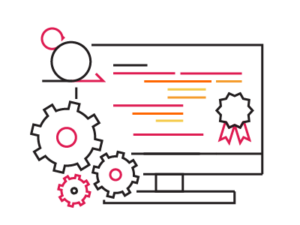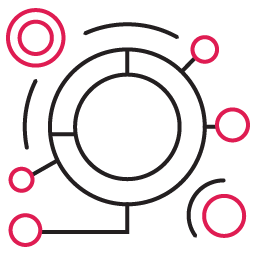Speaking to purists on both sides, you could easily come away believing that IT service management (ITSM) and DevOps are two very different practices—perhaps even at odds with each other.
But, many modern practitioners feel differently. They see more in common between the two than differences. What’s more, they believe marrying the two practices together is the only way to truly get the most out of both.
So, which view is correct?
Why might ITSM and DevOps butt heads?
 DevOps is all about fast delivery of quality code that adds value for the customer. It relies heavily on automation and the application of Agile principles to streamline the entire software development life cycle.
DevOps is all about fast delivery of quality code that adds value for the customer. It relies heavily on automation and the application of Agile principles to streamline the entire software development life cycle.
The priorities of an ITSM practice are different. It provides structure that facilitates (among other things) the orderly collection, prioritization, and management of necessary changes to IT systems. A prominent example of a change the ITSM system seeks to manage is when a critical bug appears and customers are being severely affected.
The DevOps teams, charged with quickly deploying software improvements, may feel they don’t have the time to check with the change advisory board, as ITSM requires, for approval to make the necessary change to the IT environment. Yet the operations people, charged with maintaining a stable, reliable environment under ITSM, can’t just let changes through without any record.
The resulting friction often leads to compromises that can be detrimental to both practices. In some organizations, speed of delivery may trump strict process. This can sometimes result in costly problems with regulatory compliance or poor decisions. Meanwhile, other organizations may prioritize the strict bureaucracy, allowing it to impede the speed and flexibility software development requires to be competitive in modern markets.
To remain competitive, satisfy customers’ needs and desires, and scale effectively, companies need to strike a balance that takes advantage of the strengths of both ITSM and DevOps.
What brings ITSM and DevOps together?
Despite what could be seen as their inherent differences, ITSM and DevOps actually share their most important outcome: delivering customer value consistently.
The customer demands that the product work properly, and that it stays up-to-date with new or refined features that continue to meet their needs. If problems come up, especially if these issues impede the customer’s ability to fully utilize the features that convinced them to buy the product in the first place, they rightfully expect these problems to be solved quickly and not to resurface. If these demands aren’t met, the customer is no longer receiving value and they’re likely to jump ship.
So, both ITSM and DevOps practitioners share the goal of making sure the customer never gets to that point. Accomplishing that goal, especially at scale, requires that they work together.
Achieving the optimal balance between ITSM and DevOps
 Back in 2020, Gartner’s whitepaper 3 Steps to Agile IT Service Management, made a bold claim: that by 2023, 80% of ITSM teams that have not adopted an agile approach will find their ITSM practices are ignored or bypassed.
Back in 2020, Gartner’s whitepaper 3 Steps to Agile IT Service Management, made a bold claim: that by 2023, 80% of ITSM teams that have not adopted an agile approach will find their ITSM practices are ignored or bypassed.
But that doesn’t mean DevOps “wins” this battle. The fact is, “ITSM provides a base set of operational requirements that ensure that the output produced by each product team is stable, operable and supportable,” according to Gregg Siegfried, research director on the cloud and IT operations team at Gartner.
So, experts agree that balance is what’s required.
Ola Chowning, a partner at Information Services Group, or ISG, an IT research and consulting firm, said, “CIOs must modernize their ITSM disciplines, but there’s also a need for changes in DevOps practices. ITSM has traditionally put up high guardrails to ensure control, while DevOps often favors none; they both need to accept at least low guardrails.”
Here are some tips to help organizations achieve that balance:
- DevOps practitioners, learn to embrace some structure. While speed and agility are necessary, flying without sufficient controls is dangerous. Be willing to adapt to the minimal level of controls that will ensure the company maintains compliance and makes the best strategic decisions.
- ITSM practitioners, learn to accept the need for flexibility. There’s no getting around the need for speed and agility in modern software development. The newest ITIL framework actually incorporates a lot of DevOps-related recommendations and language, offering excellent advice to support this change in mindset.
- CIOs and CTOs, support your ITSM and DevOps practices with process refinement and training. The teams looking to strike the balance between DevOps and ITSM can’t do it without sufficient knowledge of how to do so, or while bucking against organizational requirements.
- Make the most of the available tools to support CI/CD within a minimal ITSM structure. Products designed to support ITSM and DevOps are becoming increasingly integrated in support of this vital balance between disciplines. For example, automating the approval process for all but the highest-priority critical changes can speed up delivery and free up those making the approvals to jump immediately onto changes that matter most. A common integrated DevOps toolstack may include
- Discover – Atlassian Jira Product Discovery
- Plan – Atlassian Jira Software and Confluence, or Aha
- Build – Kubernetes or Docker
- Test – GitLab or GitHub
- Monitor – Snyk
- Operate – Atlassian Jira Service Management, Jira Software, OpsGenie
- Continuous feedback – Atlassian Jira Service Management, Slack
If you’re ready to work toward eliminating the friction and balancing your ITSM and DevOps practices, a great first step is learning more about it. Invest some time with the following resources:
- Webinar on demand: DevOps: There and Back Again (A Q&A with Our DevOps Experts)
- Webinar on demand: Tips to Make a Lean, Mean ITSM Machine with Atlassian




 ESM stands for Enterprise Service Management and is often defined as “the use of
ESM stands for Enterprise Service Management and is often defined as “the use of  An optimal ESM program includes some combination of the following five core elements:
An optimal ESM program includes some combination of the following five core elements: A successful ESM solution must incorporate reporting that is robust enough to monitor both current and historical requests. Ideally, the team will use this reporting to routinely inspect the ESM practice and support continual improvement.
A successful ESM solution must incorporate reporting that is robust enough to monitor both current and historical requests. Ideally, the team will use this reporting to routinely inspect the ESM practice and support continual improvement. Atlassian launched Jira Service Desk in 2013 but soon found that 40 percent of their customers adopted it for internal requests. To facilitate this use and harness the power of IT service management (ITSM), Atlassian then launched JSM for comprehensive service delivery.
Atlassian launched Jira Service Desk in 2013 but soon found that 40 percent of their customers adopted it for internal requests. To facilitate this use and harness the power of IT service management (ITSM), Atlassian then launched JSM for comprehensive service delivery. You can use JSM’s automation capabilities to reduce the burden on your teams and free up time. This allows organizations to automate manual, repetitive tasks to improve their efficiency.
You can use JSM’s automation capabilities to reduce the burden on your teams and free up time. This allows organizations to automate manual, repetitive tasks to improve their efficiency. Too often, customers or employees register support tickets for minor issues, which increases the load on your team and results in redundant tickets. Avoid this issue by leveraging Confluence’s knowledge base feature—a powerful tool for companies to empower employees and customers.
Too often, customers or employees register support tickets for minor issues, which increases the load on your team and results in redundant tickets. Avoid this issue by leveraging Confluence’s knowledge base feature—a powerful tool for companies to empower employees and customers.

 ITIL is a proven, stable, and extensible foundation for service management in any industry. The best practices it describes accommodate a wide range of implementations and toolsets, of which the Atlassian Cloud suite of tools remains a prominent solution.
ITIL is a proven, stable, and extensible foundation for service management in any industry. The best practices it describes accommodate a wide range of implementations and toolsets, of which the Atlassian Cloud suite of tools remains a prominent solution. Agile methodology and the
Agile methodology and the 
 It’s no secret that reducing mean time to resolution (MTTR) is a key objective for many organizations, so it’s no surprise that this has been an area of focus for ITSM tools.
It’s no secret that reducing mean time to resolution (MTTR) is a key objective for many organizations, so it’s no surprise that this has been an area of focus for ITSM tools.